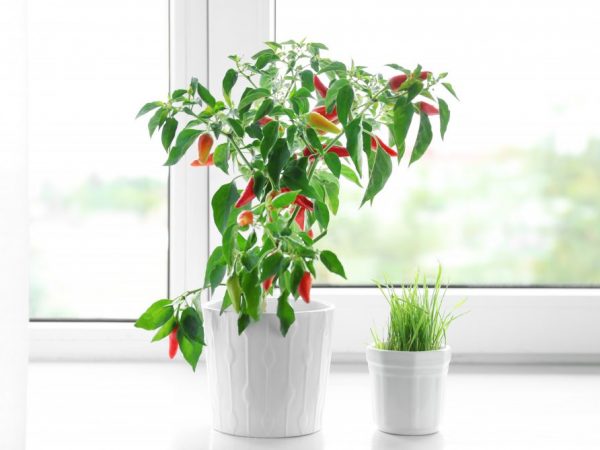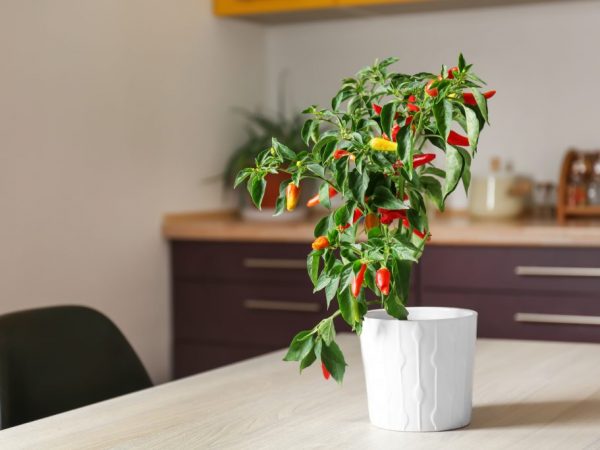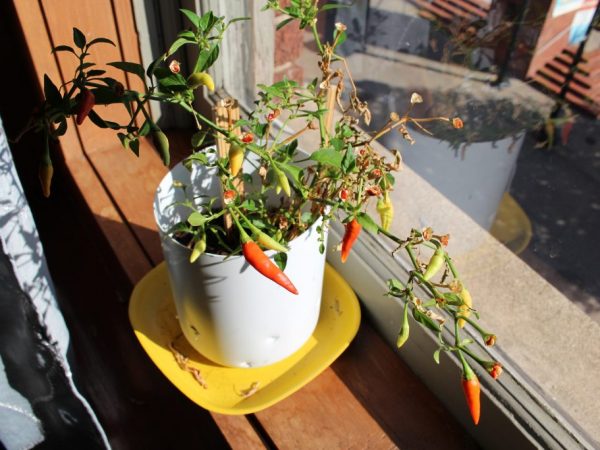Growing chili peppers at home
Most lovers of savory spices love the pungency of hot peppers. Red spicy fruits have become so popular that many gardeners have adapted to get them at home. Growing chili peppers at home can seem like a daunting task for the gardener.

Chili peppers at home
But, there is nothing special about growing this pepper. The main thing is to change the agro-technical approach to the culture and fulfill all the requirements for caring for it.
Characteristics of the variety
Chile is not a variety, but a whole genus of peppers (hybrids, more often annuals). Such varieties as "Aladdin", "Tabasco", "Salut", etc., are popular representatives of Chile, belonging to the Solanaceae family, which gardeners have adapted to grow at home. The classic progenitor, is a perennial crop grown in the open spaces of North America.
Indoor chili pepper is a stunted shrub that often performs a decorative function. The size of the bush, as well as the description of the fruits, depends on the variety selected for planting. But, one thing is invariable - this is the benefits of the product. The fruits of chili peppers are distinguished by different contents of capsaicin, which emphasizes the peculiarity of the taste of the culture. They also contain beta carotene, thiamine, pyridoxine and other trace elements. The beneficial properties of such a product are unique.
Description of bushes
Most often, home-grown peppers grow up to 50 cm in height. The leaves are small, elliptical, dark green. The shrub plant has a bright appearance, and during the fruiting period it also has a scent.
Most often, gardeners try to grow annual undersized hybrids. Such plants, contained on the windowsill, take up no more than 40 cm of space. Their attractive appearance allows you to make pepper an additional decoration for your home. The dense deciduous part and a large number of ovaries, constantly changing their color, will not leave indifferent any gardener. Chili peppers can be grown by the window or on the equipped loggia.
Description of fruits
Depending on the variety, the fruits can be arranged in different ways. For some, they are directed upwards, while for others, they are chaotic. Their number also depends on the variety. So, in the popular Habanero, the fruits are small, weighing 10-15 g. But, their number can exceed 800 pieces. And a variety like Medusa produces fruits of 20-25 g, and their number is often limited to 50-60 pieces.
The color and shape can also be different. Some are pointed, while others are curved. The variety Small Miracle is distinguished by an abundance of shades. Its peppers, during the ripening period, constantly change their colors from green to:
- yellow;
- Orange;
- purple;
- red.
There is also the Black Pearl variety, which has an exotic appearance. The pepper of such a plant looks like large black peas. Its taste is moderately spicy, with a hint of sweetness. But, it is very difficult to care for him, due to his capriciousness in the choice of soil and growing temperature.Therefore, you can plant proven, less capricious varieties at home, such as: Salute, Phoenix, Troll, etc.
Growing

Germinating seeds
Having decided to grow hot chili peppers on your windowsill, it is important to buy high-quality planting material - seeds.
You will also need plastic cups or pressed peat pots. You will have to make the substrate for planting yourself. A mixture is best suited:
- sod land (2 parts);
- peat (2 parts);
- vermiculite (part 1).
You can also add 1 part of fine sand to this mixture. But, before using it, an oven baking procedure will be required.
Planting seeds
Seeds are easy to germinate. You need to moisten two paper towels and place a handful of seeds between them. You can plant them only when sprouts emerge from the seeds. This procedure also has its own characteristics. You can plant them in a pot like this:
- In the pot, drainage is made from broken bricks.
- The prepared soil is filled up.
- 2-3 recesses are made in the ground, 2 cm deep.
- Seeds are placed in the prepared holes and sprinkled with a thin layer of soil.
- The planted seeds are watered and covered with plastic wrap.
The first seedlings in a pot will appear in 7-10 days. It is best to store the container in a warm, well-lit place. When the first leaves appear, the film is removed, and the seedlings are prepared for picking.
Indoor pepper (Chile), transplanted into a large container, into which new soil is previously poured. A large depression is made in the new pot, which will allow the pepper to be transplanted along with the earthen ball. After transplanting, you need to take care of favorable conditions for growing seedlings.
Growing conditions
Potted peppers can be placed on the windowsill. Such a culture loves sunlight, therefore, the best place for it would be a southeast or southwest window. It is best not to store containers with seedlings close to the heating radiator, as they dry out the air.
Other conditions for active growth are also important:
- the air temperature will be within 24-27 ° С;
- the duration of daylight hours for the pepper located on the window will be equal to 14-18 hours;
- the soil will be loose and moist.
Large daylight hours are regulated by additional lighting. To do this, a phytolamp should be installed next to the plant. Its goal is to build green mass. Without additional lighting, plants grown from seeds will stretch in height, but remain weak.
The safest distance to plantings is 25-30 cm. In order to accurately limit the duration of daylight hours, it is necessary to equip the lamp with a timer.
Care advice

Pepper care is not difficult
Caring for such a plant comes down to simple rules:
- Watering. Culture loves moisture, but overflowing culture is dangerous. Watering should be moderate, once a week. In hot summer, you can water the plant 1 time in 3 days, additionally sprinkling its leaves with warm water.
- Top dressing. Fertilizer should be balanced. Once every 30 days, use complex formulations. Before flowering, it is best to use humus infusion or add wood ash.
- Pruning. Used for perennial Chile. In early spring, you should carry out anti-aging pruning, by removing dried and weakened branches.
- Pollination. This culture is self-pollinated. But, due to the fact that the pepper is grown at home, it needs help. For pollination, you need to gently shake the buds or collect the pollen with a soft brush and walk it over all the flowers of the plant.
With proper care, Chile blooms in late spring, usually in mid-May. Flowering is long, and often lasts until mid-summer, when the first peppercorns begin to appear.
The main advantage of chili peppers is also that this crop lends itself to propagation, both by seeds and cuttings. The easiest way is to get seeds from your home harvest.For cuttings, several lignified shoots are required. But, do not forget that most of Chile's varieties are hybrids. That is, they may not inherit the qualities of the mother bush.
Diseases and pests
This exotic crop is rarely attacked by pests and does not suffer from diseases. The secret of culture immunity lies in its fruits. They have bactericidal properties, which is why many diseases are not dangerous to the culture. Culture can suffer from improper care:
- Over-watering can show signs of a fungal infection known as Blackfoot. This problem is solved by spraying with fungicides.
- From excessive dryness of the air, as well as from rare ventilation, aphids and spider mites can threaten seedlings. Ovaries often fall from these pests, therefore, it is important to find the most effective remedy against them. A popular remedy against pests is a solution of tar or laundry soap.
- Midges. You can deal with them in the same way as with other pests. The most effective remedy is a solution of laundry soap.
Some gardeners also use the burning fruits of the plant against diseases and pests. They must be ground and filled with a little water. Insisting such a remedy for 2-3 days, filtering it and diluting it with a tablespoon of liquid soap, you can get an excellent bactericidal agent. Spraying is carried out once a day for 4-7 days.
Conclusion
When growing chili peppers, it is important to carefully follow all the care features. Culture loves warmth and moisture, as well as sunshine. While temperature and watering problems are easy to solve, lighting is more difficult. Additional lighting with phytolamps is required.
It is best to grow perennial plant varieties. Their average lifespan is 4-5 years. When cared for properly, a houseplant will produce large amounts of red, spicy fruit.

